Surfing has always been more than a sport. It is a rhythm, a ritual, and, for many women, a revolutionary act. From ancient Hawaiian royalty to Olympic podiums, the journey of women in surfing is a tale of resurgence, resilience, and transformation. In this 2025 edition, we dive deep into every facet of women in surfing: from history to global movements, motherhood to mental health, and entrepreneurship to equality. This comprehensive overview aims to celebrate the women reshaping wave culture while exploring the systemic challenges they continue to face. Every section now includes detailed expansions and rich context to honor the depth and scale of women’s impact on surfing.
Ancient Roots: Hawaiian Queens of the Waves
Long before colonialism reshaped the Pacific, surfing was a sacred practice throughout Polynesia. Nowhere was this more deeply embedded than in Hawaii, where both men and women shared equal access to the sport. Women like Queen Kaʻahumanu were revered not only for their leadership but also for their skills in the water. Surfing was a display of status, joy, and community, and women participated without restriction.
Hawaiian women surfed on heavy wooden olo boards, which were often reserved for nobility. The act of surfing was spiritual and celebratory, not competitive. Gender roles in the lineup did not exist in the way we understand them today. European contact disrupted this balance. Christian missionaries considered surfing sinful and discouraged public play, especially among women, which led to a decline in participation.
However, the legacy of these early queens remains central to modern Hawaiian surf identity. Today’s Hawaiian female surfers—like Kelia Moniz—honor this lineage by blending traditional grace with modern athleticism, reminding the world that surfing’s roots were always inclusive and powerful.
The Feminist Surf Movement
The feminist surf movement emerged in the 1970s as a direct response to the marginalization of women in both professional competitions and surf culture. Jericho Poppler, a former US champion and painter, became one of the first outspoken figures. She used her media presence to question the bikini-centric marketing of women surfers and helped organize all-women surf events.
Rell Sunn, known affectionately as the “Queen of Makaha,” combined fierce athleticism with compassion and community activism. Diagnosed with cancer in her 30s, she continued to surf and became a symbol of hope and determination. She co-founded the Women’s Professional Surfing (WPS) organization, which was a precursor to today’s WSL women’s division.
This era also saw the birth of the first women’s surf magazines and local clubs, which helped build an international sisterhood among surfers. It wasn’t just about competing—it was about reclaiming a cultural space. Surfing became a form of resistance—a way for women to assert bodily autonomy, creative expression, and political presence in the water.
World Champions: Redefining Excellence
Caroline Marks @caroline_markss

Caroline burst onto the scene with an aggressive backhand and impeccable timing. At just 15, she qualified for the World Surf League Championship Tour, and by 22 she had won her first Olympic gold medal at Teahupo’o, one of the most feared breaks in the world. She trains rigorously in both California and Tahiti and advocates for ocean protection programs in schools.
Caroline is known for her tenacity in hollow reef waves and is leading a generation that no longer questions whether women belong in heavy surf. She openly mentors younger girls, promotes body confidence, and regularly visits high schools to speak on mental resilience.
Caitlin Simmers @caitysimmers

A skate-style phenom from Oceanside, California, Caity Simmers redefines what it means to ride creatively. She landed her first win on tour at just 17 and has since inspired a wave of younger girls to pursue competitive surfing without compromising on artistic flair. Her social media presence offers daily inspiration and showcases her passion for music and painting.
She’s part of a Gen Z cohort that uses style and social media to push back on the uniformity of competitive surfing, advocating for authenticity and freedom of expression in everything from wetsuits to trick selection.
Stephanie Gilmore @stephaniegilmore

The elegance of Stephanie Gilmore’s surfing is matched only by her longevity. With eight world titles, she holds the record for the most by a woman. She is also a UN ambassador and runs her own surf camp for indigenous Australian girls, where she teaches both surfing and leadership skills.
Stephanie helped push through WSL’s equal pay policies and continues to mentor female athletes worldwide. Her fluidity on a wave is often compared to jazz—effortless, timeless, and profound.
Tatiana Weston-Webb @tatianawestonwebb
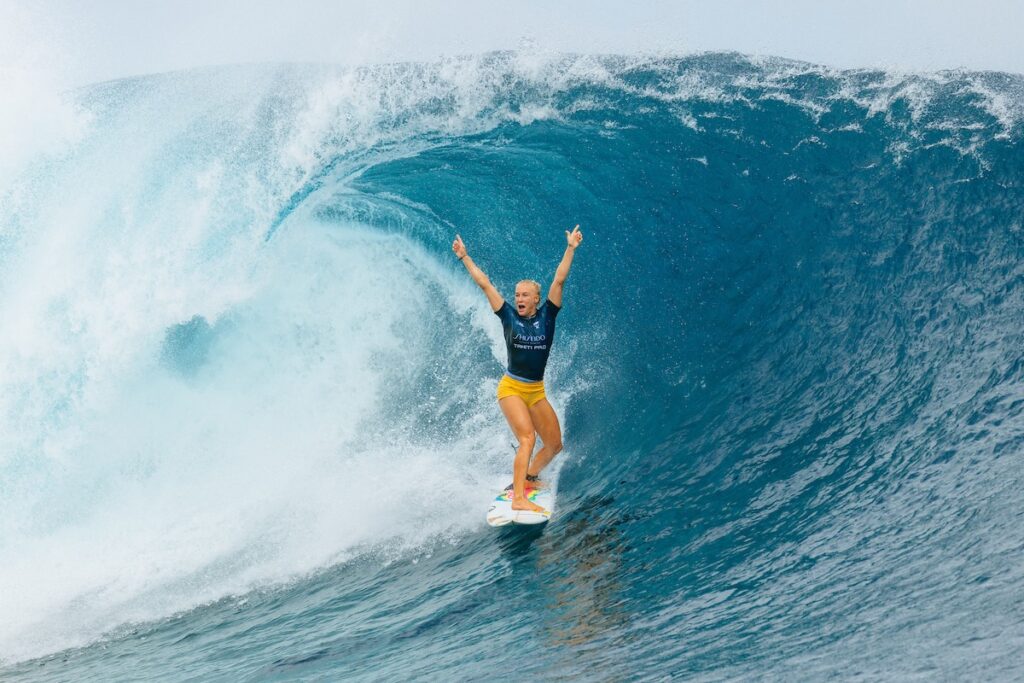
A surfer who blends power with precision, Tatiana is one of Brazil’s leading athletes. Raised in Hawaii and fluent in Portuguese and English, she’s uniquely positioned to build bridges between surf communities worldwide. She regularly speaks at schools and women’s empowerment events.
Her backside attack at reef breaks is among the most aggressive on tour, and she’s known for her fierce work ethic and commitment to mental health awareness. Tatiana has also modeled for several eco-conscious surf brands and supports sustainable fashion initiatives.
Big-Wave Pioneers: Fearless in the Face of Giants
Maya Gabeira @maya
Maya Gabeira is a symbol of perseverance in big-wave surfing. Born in Brazil and raised in Rio de Janeiro, she was the first woman to surf many of the world’s most dangerous breaks. After a near-fatal wipeout at Nazaré in 2013, she returned to the same spot to break the Guinness World Record for the largest wave surfed by a woman—73.5 feet. She is also a UN ambassador for ocean preservation and is vocal about mental health in high-performance sports.
Laura Enever @lauraenever
A former CT surfer from Sydney, Australia, Laura transitioned into big-wave surfing after stepping away from the World Tour. Her documentary “Undone” chronicles this journey, and in 2024 she successfully surfed one of the biggest waves ever ridden by a woman in Australia. Laura’s energy, style, and raw courage have made her a household name among big-wave aficionados.
Paige Alms @paigealms
Living in Maui, Paige has been charging Peʻahi (Jaws) since the early 2000s. She was the first ever women’s champion at the WSL Peʻahi Challenge in 2016. Paige is not only a phenomenal surfer but also a vocal advocate for equal access to big-wave events, helping to open up historic male-only contests like Mavericks to women.
Longboarding Legends: Style Masters
Kelia Moniz @keliamoniz
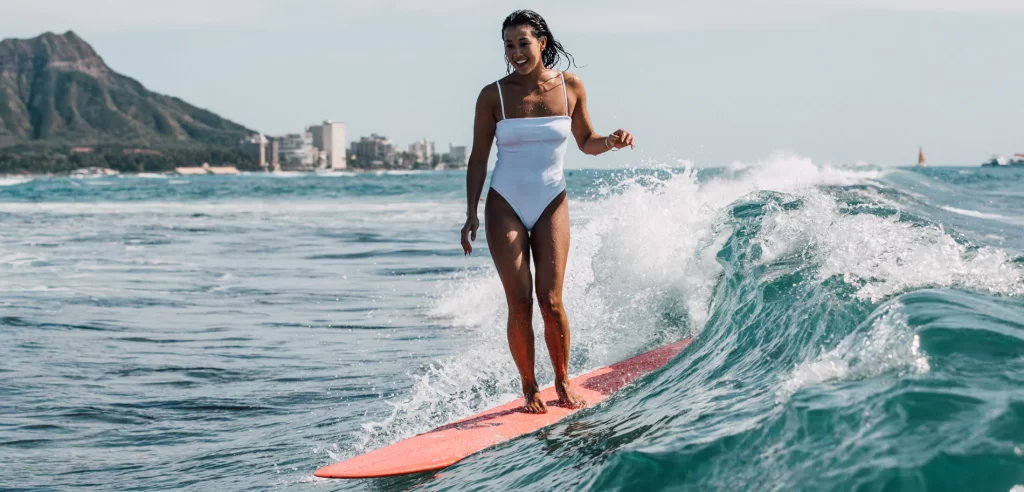
Kelia is a two-time WSL Longboard Champion and an icon of elegant surfing. Coming from a multi-generational Hawaiian surf family, she blends cultural grace with technical mastery. Known as “Sister” in the surf world, she represents Roxy and co-hosts retreats promoting female empowerment through surf and wellness.
Honolua Blomfield @honoluablomfield
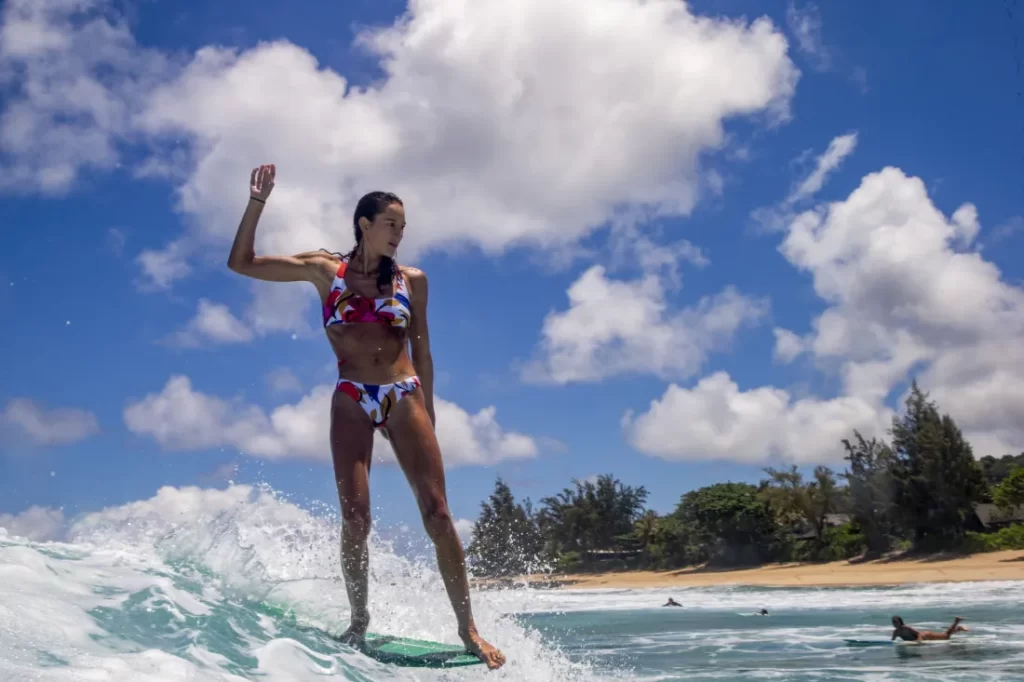
Honolua began surfing at the age of 3 and has become one of the most dominant longboarders in the modern era. With multiple world titles, her fluid noserides and commitment to traditional logging have helped bring classic longboarding back into the mainstream spotlight.
Chloe Calmon @chloecalmon
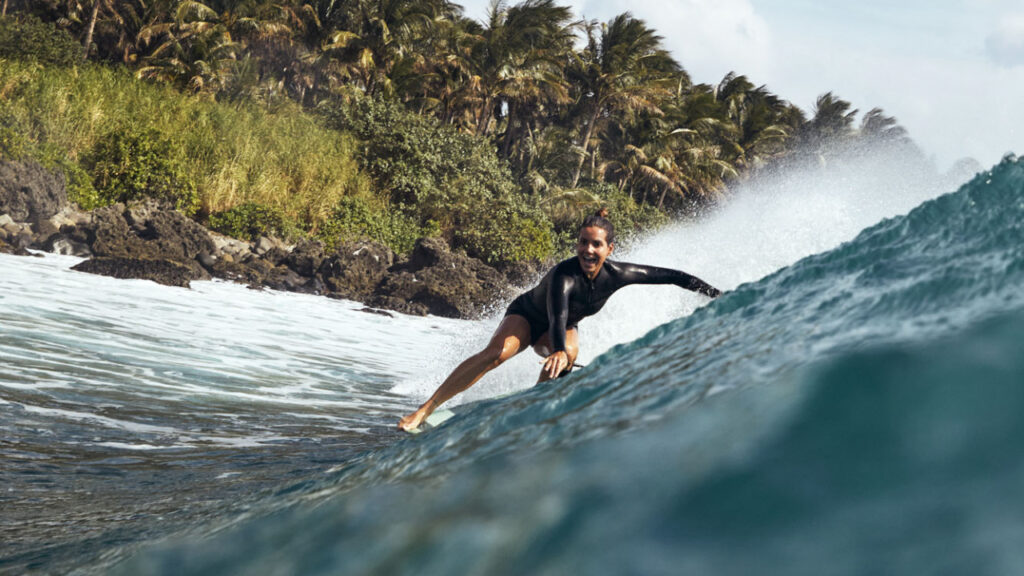
Brazil’s premier longboarder, Chloe has become a cultural ambassador for women’s surfing in South America. Her poised, powerful style is matched by her dedication to environmental causes and her mentorship of local surfers in underserved communities.
LGBTQ+ Representation in Surfing
While surfing has historically been portrayed as a heteronormative subculture, the past decade has seen a strong emergence of LGBTQ+ visibility in the lineup. This shift has made surfing more welcoming for queer athletes and challenged traditional surf stereotypes.
Keala Kennelly @kealakennelly
A former top-ranked pro shortboarder turned big-wave specialist, Keala is one of the most outspoken queer athletes in surf history. She’s won at Teahupo’o, taken podiums at Jaws, and broken barriers with her candor about identity, sexism, and mental health. Keala’s advocacy has opened doors for many LGBTQ+ surfers who once felt marginalized or unsafe in lineups.
Sierra Lerback @sierralerback
Sierra is a longboarder and influencer who proudly represents LGBTQ+ women and nonbinary surfers. Her work with queer surf retreats and lifestyle brands helps foster inclusive spaces for youth and emerging surfers who want to feel represented in the industry.
Together, these trailblazers help redefine who belongs in surfing—everyone.
Body Positivity and Representation
Surfing media has long celebrated a narrow aesthetic: tanned, slim, bikini-clad women. But today, the community is embracing broader standards of beauty, fitness, and athleticism.
@curvysurfergirl
Founded by Elizabeth Sneed, the Curvy Surfer Girl movement has amassed over 100,000 followers and empowered plus-size women to enter the surf. Through inclusive swimwear campaigns, coaching clinics, and partnerships with brands like Roxy and Seea, she challenges the idea that only one type of body belongs on a board.
@sarahhultin
A surf coach and advocate, Sarah posts inspiring reels of her surfing powerful waves in Indonesia and California. Her message: you don’t have to shrink your body to expand your stoke. She also speaks out about diet culture and mental health in the surf community.
Women-Led Surf Brands and Entrepreneurs
The female surf revolution isn’t just happening in the water—it’s transforming the business world too. Women are now at the helm of some of the most exciting surf brands.
- Seea – Founded by Amanda Chinchelli, Seea creates functional, flattering, and ethically-made surfwear that supports freedom of movement and style.
- Salt Gypsy – A sustainable surfwear brand by New Zealand surfer Danielle Clayton. Salt Gypsy supports small-scale production and ocean-conscious fashion.
- Kassia+Surf – Founded by former pro Kassia Meador, this brand creates eco wetsuits and accessories with psychedelic aesthetics.
- Yemaya Surf – A Latinx- and woman-owned business offering functional bikinis designed for surfers of all sizes.
These brands are reshaping the market—and rewriting the narrative—one thread at a time.
Women in Surf Media
The way women are portrayed in surfing has shifted dramatically thanks to women-led storytelling:
- Lauren L. Hill – Surfer, author of She Surf, and podcast host of Waterpeople. Her work blends surf history, ecology, and feminism.
- Joni Sternbach – A fine-art photographer using tintype methods to capture timeless portraits of surfers across genders.
- Emily Erickson – A North Shore surfer and writer who pens essays about women’s role in surfing for The Surfer’s Journal and other publications.
Digital platforms like Instagram and YouTube have also empowered self-produced surf content. Women now control their narrative—from camera angles to soundtracks—expanding the possibilities of what surf media can be.
Women in Surf Competitions and Advocacy

Women’s involvement in professional surf competitions has surged in the past decade, with key milestones that mark a radical transformation in the sport’s culture and governance.
Equal Pay in the WSL
In 2019, the World Surf League (WSL) announced equal prize money for men and women across all events—an industry first. This came after years of pressure from athletes like Stephanie Gilmore and organizations such as Surfrider Foundation and the Commission for Gender Equality in Sport.
Olympic Representation
The 2021 Tokyo Olympics marked the debut of surfing as an Olympic sport. Carissa Moore took gold in the women’s division, while Caroline Marks made headlines as the youngest U.S. Olympic surfer. In 2024, surfing returned to the Paris Olympics (held in Tahiti), further boosting visibility for women’s surfing.
Women-Only Surf Events
- Super Girl Surf Pro (USA) – The largest women’s-only surf competition in the world.
- Queen of the Point (Australia) – A longboarding event celebrating style, heritage, and sisterhood.
- Red Bull Magnitude (Hawaii) – A big-wave contest that awards performances based on video submissions across the season.
These competitions create equitable platforms that recognize talent, encourage sponsorship, and draw attention from global audiences.
Global Surf Sisterhoods and Grassroots Movements
All over the world, women are building inclusive surf communities that empower through education, sustainability, and cultural respect.
Sea Sisters Sri Lanka
This nonprofit teaches young Sri Lankan women to swim and surf, helping break taboos around women’s presence in public waters. The program includes swim lessons, surf therapy, and safe community events.
SurfearNEGRA (USA)
Dedicated to increasing diversity in surfing, SurfearNEGRA connects Black and Latinx girls with surf instructors, scholarships, and long-term mentorship.
Beyond the Surface International
Founded by Easkey Britton, this organization runs surf-based programs in India, Iran, and Indonesia focused on healing from trauma, environmental education, and gender equality.
These initiatives don’t just teach surfing—they build confidence, reduce social isolation, and foster a global sisterhood of ocean lovers.
The Surf Economy and Women’s Financial Impact
Women are not only driving performance and representation in surfing—they’re also reshaping its economy. Female surfers and entrepreneurs are helping shift the industry toward sustainability, inclusivity, and empowerment-based branding.
- Women-led surf retreats (like Surf With Amigas and Women + Waves) make up a growing slice of wellness tourism, valued at over $639 billion globally.
- Female-owned brands such as Seea and Kassia+Surf are raising the bar for eco-conscious gear, creating opportunities for investors and creators alike.
- Athletes like Stephanie Gilmore and Bethany Hamilton have monetized their brands across books, films, and endorsements while championing social causes.
The future of surf isn’t just female—it’s financially fluent.
Mental Health and Surf Therapy
Surfing has long been associated with spiritual freedom, but in recent years, it’s also being formally adopted as a form of therapy for trauma recovery, anxiety, and burnout.
Programs like Groundswell Community Project (USA), Surf Therapy Sri Lanka, and Waves for Change (South Africa) use surfing as a healing modality. Their programs focus on:
- Emotional regulation and resilience
- Confidence building
- Community support and peer-to-peer healing
These groups offer specific programs for survivors of domestic violence, addiction recovery, and marginalized identities.
Coaching, Mentorship, and Education
More women are becoming certified surf coaches and safety experts, creating new pathways for leadership in the sport. Organizations now offer:
- Women-only surf instructor certifications
- Coaching for adaptive surfers and para-athletes
- Educational scholarships for female athletes in developing regions
High-level pros like Rosy Hodge, Rochelle Ballard, and Bianca Valenti now mentor the next generation both on land and in the water.
Technology, Innovation, and Women in Surf Science
From wave forecasting to wetsuit design, technology is transforming surfing—and women are shaping its future:
- AI + Wearables: Surfers now use smart watches and surf trackers to analyze performance and wave count.
- Wave Pools: Women are training in artificial surf environments for consistency and safety.
- Marine Science: Surfer-scientists like Easkey Britton use academic research to tie surf culture to ocean conservation and climate activism.
These developments support faster progression and broader access to the sport.
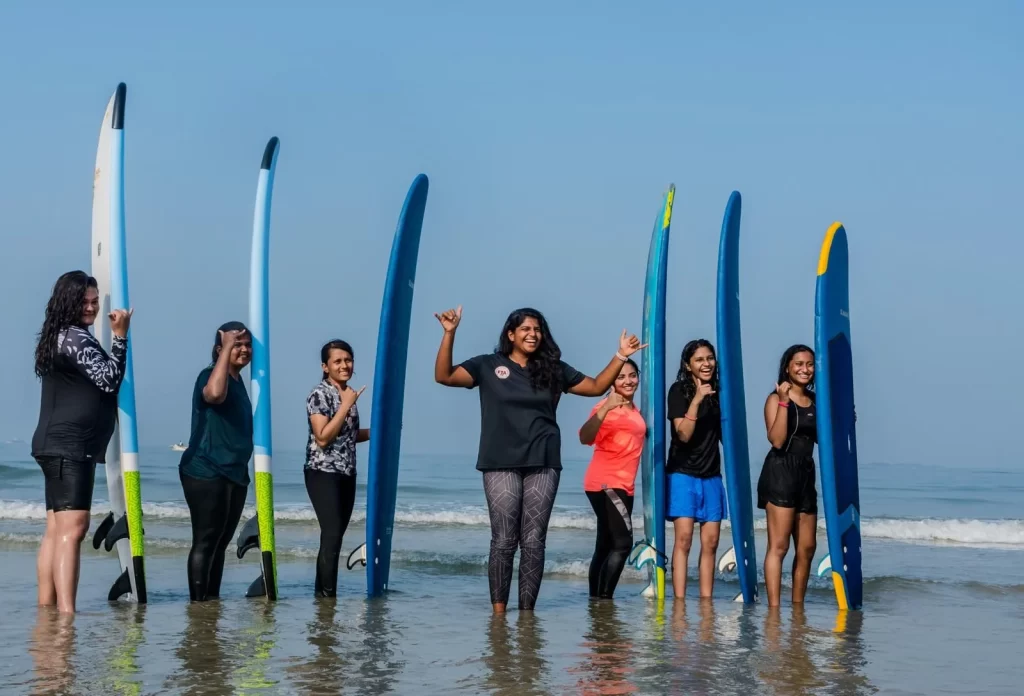
Final Wave: The Future is Female and Fluid
The future of surfing is bold, intersectional, and global. Women are no longer asking for a seat at the table—they’re building their own.
From carving giant barrels to founding tech companies, from mentoring young girls to reshaping media, women are redefining what it means to surf—and who gets to ride the wave.
This is not just a shift in participation—it’s a transformation of surfing’s soul.

